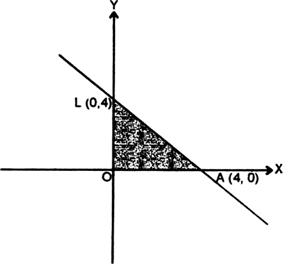Solve the following Linear Programming Problems graphically:
Maximise Z = 3x + 4y
subject to the constraints: x + y ≤ 4, x ≥ 0, y ≥ 0
We are to maximise
Z = 3x + 4 y
subject to the constraints
x + y ≤ 4
x ≥ 0, y ≥ 0
Consider a set of rectangular cartesian axes OXY in the plane.
It is clear that any point which satisfies x ≥ 0, y ≥ 0 lies in the first quadrant.
Let us draw the graph of x + y = 4
For x = 0, y = 4
For y = 0, x = 4
∴ line meets OX in A(4, 0) and OY in L(0, 4)
Since feasible region is the region which satisfies all the constraints.
∴ OAL is the feasible region. The comer points are O(0, 0), A(4, 0), L(0, 4).
At O(0, 0), Z = 0 + 0 = 0
At A(4, 0), Z = 12 + 0 = 12
At L(0, 4), Z = 0 + 16 = 16
∴ maximum value = 16 at (0, 4).





